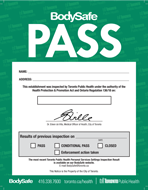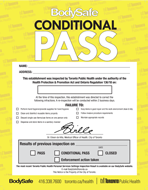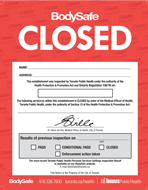
BodySafe is Toronto Public Health’s safety program that inspects personal service settings (PSS). PSS are premises that provide personal services where there is a risk of exposure to blood or body fluids and includes premises offering hairdressing and barbering, tattooing, body piercing, nail services, electrolysis and other aesthetic services.
All health units in Ontario must conduct an health inspection and follow up on complaints associated with PSS. This process ensures that owners and operators operate their business in accordance with Ontario Regulation 136/18: Personal Service Settings under the Health Protection and Promotion Act and the Public Health Ontario’s Guide to Infection Prevention and Control in Personal Services Settings.
The purpose of the BodySafe program is to ensure that PSS owners/operators use safe practices to prevent the spread of infections, such as:
Personal service settings are businesses that provide the following services:
All establishments offering personal services as indicated under Municipal Code 545, Licensing By-Law, will be required to get a PSS license and post their inspection notices at or near the entrance of the business, so that it is clearly visible to the public.
There are two types of inspection results that will be posted on BodySafe web pages:
An inspection is likely conducted once a year by a Public Health Inspector.
A re-inspection is conducted if there are any infractions identified during the original health inspection. Re-inspections will likely occur within 48 business hours if a service or establishment is not closed.
The establishment level inspection result provides the overall outcome of the inspection.
| Inspection Report | Notice | Infraction Examples |
|---|---|---|
Pass
|
 |
|
| Conditional Pass
Significant infractions:
|
 |
|
| Service(s) Closed
Crucial infractions:
|
 |
|
| Establishment Closed
Crucial infractions:
|
Each establishment has at least one personal service they provide to the public, such as hairstyling. In many cases, one establishment can provide several different types of services, such as hairstyling and ear piercing. An establishment that provides more than one service is called a multi-service establishment. There are four inspection results that can occur at the service level.
| Inspection Result | Example |
|---|---|
| Satisfactory
No infractions are identified during the inspection or re-inspection |
Inspected the hair and ear piercing services and both services had no infractions. |
| Not satisfactory
One or more infractions were identified during the inspection or re-inspection. |
Inspected the hair and ear piercing services. Hair services had no infractions, but the ear piercing device was not cleaned properly. |
| In progress
An inspection of a service was attempted but could not be completed. |
The hair service was inspected but the person who provides ear piercing was not available that day for an inspection. The Inspector will need to return to complete the ear piercing inspection. |
| Service closure
A service was ordered to close until infractions associated with that service are all corrected. |
The ear piercing service was closed because there was no disinfectant to disinfect the device at the establishment. |
Each PSS establishment is categorized into three risk levels depending on the type of services that are provided in the establishment. All establishments are inspected when there is a complaint, regardless of risk level.
| Establishment Risk Level | Minimum Number of Inspections per Year | Risk Assessment Criteria |
|---|---|---|
| Critical | Once per year and Complaint basis | A service that uses any tools or items that penetrates the skin or mucous membranes (used for invasive procedures). Examples of services:
|
| Semi-Critical | Likely Once per year and Complaint basis | A service that uses any tools or items that contact non intact skin or mucous membranes, but is not intended to penetrate them or enter normally sterile areas. Examples of services:
|
| Non-Critical | Complaint basis only | A service that uses any tool or item that do not directly contact the client, or contact only hair or intact skin. Examples of services:
|
If you are considering opening a PSS in your home, make sure you have approval from Zoning before you request your health inspection or apply for a PSS licence. You can submit an application through Zoning for a fee, to confirm the use of your property for compliance with Zoning By-Laws.
Special events (including conventions, expos, shows, and fairs) in the City of Toronto that offer personal services on-site must comply with infection prevention & control guidelines and with all applicable sections of Ontario Regulation 136/18.